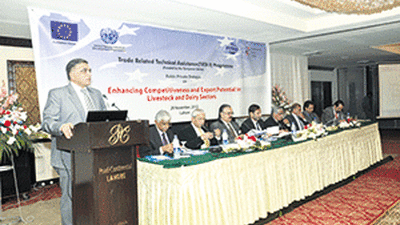Easing the burden of non-tariff barriers
In industrialized countries tariffs have fallen to about one-tenth of what they were, largely as a result of negotiations fostered by the General Agreement on Tariffs and Trade (GATT). In developing countries progress came later and has been less, but most developing economies have seen the wisdom of reducing tariffs quite substantially. Progress in reducing tariffs has, in part, exposed existing non-tariff barriers (NTBs) and, more so, prompted countries at all levels of development to invent new NTBs to serve the purposes that could no longer be achieved through tariffs. Thus, today, NTBs are by far the largest impediment to trade.
Some expansion of NTBs has been deliberately protectionist, but more has been the unintended or even unexpected by-product of policies pursued for other purposes. Regardless of these purposes, NTBs can severely hamper trade and interfere with countries' abilities to prosper by integrating with the world economy. This raises the question of whether today's international trading system is capable of dealing adequately with NTBs. One hope for doing so was the Doha Round of trade negotiations that began in 2001 under the auspices of the World Trade Organization (WTO). The Doha Development Agenda was intended to reduce or remove many forms of barriers to trade as well as cut back subsidies that are often just as disruptive, even though they may expand trade. The Doha Round has entered its eleventh year of negotiations and there are no signs that it will accomplish very much, if indeed it ever concludes. So, there seems to be no hope that NTBs will be reduced or constrained by multilateral negotiations.
This does not mean the WTO has lost its relevance. On the contrary, the WTO Dispute Settlement Mechanism (DSM) continues to function well and effectively, and is expected to continue to do so. To the extent that it is able to address NTBs, the DSM is expected to become more important for this purpose over time. At the same time that multilateral negotiations within the WTO have languished, negotiations outside the WTO to form Free Trade Areas (FTAs) and other preferential trading arrangements have proliferated. One might imagine that attempts to address NTBs will shift from the WTO to FTAs; and to some extent that may occur. Similarly, there has been some success in addressing trade issues outside the full multilateral context and independently of FTAs through plurilateral negotiations among groups of countries with a shared interest. This form of negotiation promises scope in addressing particular NTBs. To understand how these various mechanisms may or may not work in addressing NTBs, it is helpful to distinguish NTBs by their purpose. Attempts to curtail NTBs are bound to fail if they do not take into account what countries are trying to accomplish when they are created. There are three categories of NTBs: protectionist policies; assistance policies; and non-protectionist policies.
• Protectionist policies are used by countries for the avowed purpose of helping their own firms and industries at the expense of those in other countries. This purpose has been the most common reason for levying tariffs, and preventing it has been the fundamental aim of the GATT and WTO. NTBs that serve this purpose, such as import quotas, local content requirements and public procurement practices, are often very similar to tariffs in their economic effects. GATT, which was conceived to counter such explicit protectionist motives, and the WTO have worked very well to constrain tariffs and at least moderately well to constrain these types of NTBs. Countries that use such explicitly protectionist NTBs know they will be subject to disputes in the WTO and will likely lose. For this reason, they may pull back from the brink of such overt protectionism. An example is the United States stimulus policy of 2008, which as originally drafted would have limited government expenditure on imports. President Obama was able to get the legislation modified to prevent such limits when they would run afoul of the United States's trade obligations under the WTO and North American Free Trade Agreement.
• Assistance policies aim to help domestic firms and industries, but not explicitly at the expense of foreign counterparts. Domestic subsidies fit the description as do most of the bailouts seen during and after the global financial crisis. Undeniably, these policies have adverse effects on foreign firms, but that is not their purpose. WTO international rules find these policies harder to deal with than protectionist policies. Sovereign governments will not give up their right to assist their own constituents and WTO international rules cannot simply prohibit such policies. In the past, rules have only permitted adversely affected countries to respond to protect themselves. This is the rationale behind WTO countervailing duties that work reasonably well for the narrow category of policies, essentially subsidies, to which they apply. Unfortunately, tools do not exist to allow countries to protect themselves from the adverse effects of many other assistance policies. For example, if a bailout of a car company makes it easier for the company to compete in markets to which both it and another country export, the other exporting country has no way, aside from costly subsidies of its own, to protect its companies.
• Non-protectionist policies are, perhaps, the most interesting. They are not meant to help domestic industries and instead have other distinct purposes. Most common are policies to protect the health and safety of people, animals and plants, and policies to improve the environment. These are purposes that most would agree are legitimate and are shared by many governments, but policies put in place to achieve these objectives often turn out to cause economic harm to other countries. For example, if the health of consumers is protected by requiring food products to be inspected in a country, that creates a barrier to providers from outside even if they have similar provisions for inspection in their own countries. Similarly, from an environmental standpoint a country may seek to protect endangered sea turtles by prohibiting methods of fishing for shrimp that harm them, but as that prohibition cannot be enforced abroad, the country bans imports of shrimp from countries that do not enforce a similar prohibition. In neither case is the purpose of the policy to help domestic industry, which actually incurs increased costs as a result of the policy, but the effect of the policy harms foreign exporters. Like assistance policies, non-protectionist policies cannot be addressed by simply banning them because their purposes can be viewed as legitimate and important. The trick is to find a way to reduce their adverse effects on other countries. For some policies, this may be achieved by agreeing common standards or gaining mutual recognition of different standards. For other policies, reliance on the WTO DSM may be effective, particularly if it can put pressure on countries to find alternative means of achieving their legitimate objectives. This is precisely what happened in the shrimp and sea turtle case: a WTO decision against the United States induced the country to remove its ban on imports and replace it with technical assistance to help foreign shrimp fishers avoid harm to turtles.
This all adds up to tempered optimism that NTBs can be dealt with largely by existing institutions. With some exceptions as noted above, the WTO DSM is capable of constraining countries from the use of policies that adversely affect other members too much. Such constraint has been, and will continue to be, at least moderately effective in stopping countries from doing significant economic damage to one another. Wherever possible, the constraint of the WTO should be combined with negotiation in FTAs and plurilateral groups to achieve coordination of policies that would otherwise interfere with trade. These approaches will not solve all NTB-related problems, but they can prevent the international trading system from reverting to chaos.







